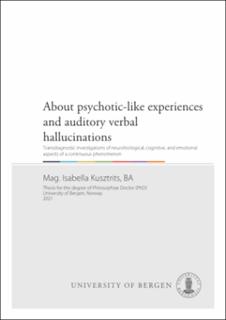About psychotic-like experiences and auditory verbal hallucinations : Transdiagnostic investigations of neurobiological, cognitive, and emotional aspects of a continuous phenomenon
Doctoral thesis
Permanent lenke
https://hdl.handle.net/11250/2987554Utgivelsesdato
2021-03-19Metadata
Vis full innførselSamlinger
Sammendrag
Hallucinations and delusions are known to be key symptoms of psychotic disorders, such as schizophrenia, and have been studied extensively. However, these experiences also occur in other mental disorders, which suggests a transdiagnostic perspective with shared underlying cognitive mechanisms across various psychological illnesses. In addition, hallucinations and delusions are continuous phenomena that occur not only in patients with mental disorders, but also in healthy individuals in the general population, spanning from childhood to adulthood. To understand the development and maintenance of such psychotic-like experiences (PLEs) in general, and auditory verbal hallucinations (AVHs) specifically, neurobiological, cognitive, and emotional factors need to be taken into consideration. The aim of this thesis is to examine these factors by investigating underlying brain mechanisms of inner speech processes, the impact of emotions, and core schemas about the self and others in different groups of individuals along the continuum from healthy individuals to voice hearers with different underlying disorders.
In paper 1, we investigated PLEs in Norway in a sample from the general population, using the screening questions of the Questionnaire for Psychotic Experiences (QPE), an interview that captures the presence and phenomenology of various psychotic experiences separately. Participants with mental disorders reported more frequent lifetime and current hallucinatory experiences than participants without mental disorders, with childhood experiences being rather low. We further replicated findings that young age, illegal drug use, lower level of education, and having parents with a mental disorder are associated with higher endorsement rates of PLEs. Finally, we revealed that the mere presence of PLEs does not discriminate between individuals with and without a mental disorder. Taken together, the findings of paper 1 support existing models that both hallucinations and delusions exist on a structural and phenomenological continuum.
In paper 2, we investigated neurobiological factors of cognitive inner speech processes by using a neurostimulation method called transcranial direct current stimulation (tDCS) to modulate source monitoring abilities in healthy individuals. We modulated reality monitoring (distinguishing between external and internal sources) and internal source monitoring abilities (distinguishing between two or more internal sources). We found that internal source monitoring abilities were significantly enhanced during active online tDCS, while reality monitoring abilities were unaffected by stimulation. Our findings suggest that there are different brain areas involved in reality and internal source monitoring: Internal source monitoring seems to involve Broca’s area. Reality monitoring, however, seems to rely more on the superior temporal gyrus (STG) and the dorsolateral prefrontal cortex (DLPFC) as shown in other studies.
In paper 3, we focused on cognitive and emotional aspects of AVHs, namely the impact of emotions and affect on AVH phenomenology in non-clinical and different clinical populations. Depending on the underlying psychopathology, these phenomena show different phenomenological aspects. Our aim was to determine the mediating roles of anxiety and depression in the relationship between positive and negative core schemas about the self and others, and emotional aspects of AVHs for three groups: non clinical voice hearers, affective voice hearers, and non-affective voice hearers. Results showed full mediating effects of anxiety in affective voice hearers in the relationship between negative core schemas and all phenomenological aspects, but not in non-affective voice hearers. Depression was not a mediator in any of the groups. These findings suggest different emotional mechanisms for different groups of voice hearers, depending on the underlying psychopathology of individuals with AVHs.
Overall, we conclude that the findings support a continuous and transdiagnostic perspective of PLEs in general, and AVHs specifically. However, more integrative transdiagnostic investigations in different groups of individuals along the continuum are needed as studying AVHs in only one modality or one clinical population is unlikely to bring us closer to understanding how these phenomena develop in the first place.
Består av
Paper I: Kusztrits, I., Larøi, F., Laloyaux, J., Marquardt, L., Sinkeviciute, I., Kjelby, E., Johnsen, E., Sommer, I. E., Hugdahl, K. & Hirnstein, M. (2021). Mapping psychotic-like experiences – results from an online survey. Scandinavian Journal of Psychology, 62(2): 237-248. The article is available at: https://hdl.handle.net/11250/2728341Paper II: Kusztrits, I., Marquardt, L., Hugdahl, K. & Hirnstein, M. (2021). Transcranial direct current stimulation (tDCS) enhances internal source monitoring abilities in healthy participants. PLoS ONE, 16(9): e0257010. The article is available at: https://hdl.handle.net/11250/2987547
Paper III: Kusztrits, I., Toh, W. L., Thomas, N., Larøi, F., Meyers, D., Hirnstein, M. & Rossell, S. (2022). From core schemas about the self and others to voice phenomenology: anxiety and depression affect voice hearers differently. Psychology and Psychotherapy: Theory, Research and Practice, 95(2): 493-507. The article is available at: https://hdl.handle.net/11250/3021740
